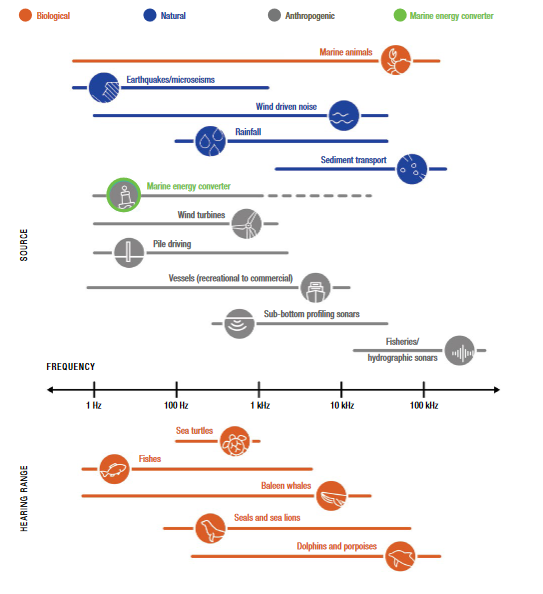Breadcrumb
- California Offshore Winds
- Noise Impacts
Noise Impacts
- What is the frequency hearing range (measured in hertz) for marine animals?
Marine animals can hear across broad ranges. Blue whales hear frequencies between 7 Hz to 35kHz. Mid-frequency toothed whales and dolphins hear between 150 Hz and 160 kHz. Seals hear between 50 Hz and 86 kHz. Sea lions hear between 60 Hz and 39 KHz. [1] As a group, marine mammals can hear somewhere between 7 Hz to 200 kHz. Sea turtles hear between 100 Hz and 1 kHz.
Marine animal perception of underwater sound is different than human perception of in-air sounds and sounds do travel faster in water than in air. Even though sound travels more quickly in water, the impact of anthropogenic sound will depend on the amount of energy in a signal. [4]
- What noise may be associated with site assessment and characterization?
Site assessment includes collecting data about not just wind profiles but also the seafloor, biodiversity in the region, and archaeological/historic resources. In particular, wind developers will be trying to ensure that wind infrastructure (turbines, mooring systems, and cables) are located to avoid creating hazards. Sources of noise during site assessments may include high-resolution geophysical surveys, geotechnical sampling (cores and cone penetration tests), vessel engines, and diesel engines for metocean buoys where solar/wind are not available.
For geophysical surveys, the companies are likely to use some form of side-scan sonar system which includes pingers that transmit sounds and then record the returning echo that travels through the water column. The frequency range for this system is expected to be between 300-500 kHz. The developers are also likely to use sub-bottom profilers that uses a high-resolution Compressed High-Intensity Radar Pulse (CHIRP), a boomer, a bubble pulser, or an impulse-type system to develop a geologic cross-section of subsurface sediment conditions.
Any noise impacts from surveys are expected to be “negligible and consist primarily of short, intermittent behavioral effects on individual animals.” [2]
- What noise may be associated with construction?
Compared to fixed bottom wind, there is significantly less noise associated with floating wind development. There may be some noise associated with anchor pile driving. The amount of noise depends on the size of a pile, the material of the pile, amount that the pile is being driven into seabed, water depth, and hammer energy. Noise abatement technologies exist to reduce pile driving noise including the use of big bubble curtains, Helmholtz resonators, and/or segmented nets made of rubber.
Vessels bringing construction materials to the wind sites including cable layers will have propeller noise. These vessels may generate noise ranging from 175-185 decibels [MC1] unit for pressure spectral density (measurement for underwater acoustics on intensity) with frequency mostly around 100 Hz but at times up to 10kHz [2]. These numbers for wind-related construction will be similar to other large vessels. [5]
Vessel Decibels Wind construction vessel 175-185 decibels 54000 Gross Tonnage container ships 188 decibels 26000 Chemical Tanker 177 decibels - What noise may be associated with operation?
The combined sound of wind turbines is lower or comparable to a small cargo ship’s noise. Larger turbines will produce more sound than smaller turbines. One prediction has a 15 MW turbine operating at 22 mph generating 125 decibel units for pressure spectral density. [2] Different technology can further reduce this noise. Floating turbine-bearing structures will mainly emanate low-frequency sounds with frequencies of less than 1 kHz. [3]
Operational vessels may generate noise. These vessels are anticipated to generate no more than 165 decibels unit for pressure spectral density with frequency up to 150 kHz because they can travel faster than ships involved with surveying or construction.[2] During operation, bottom-dwelling fish that are adjacent to a wind turbine could have their communication, foraging, and predator detection impacted by the changes in frequency depending on wind speeds. Studies on bottom-dwelling fish and the impact of sound have not been done. [2] Slower speeds on boats will reduce vessel noise in the water.
Image
Comparison of Marine Animal Hearing Ranges with Frequency from human generated and non-human generated noise in the marine environment https://tethys.pnnl.gov/sites/default/files/summaries/SEER-Educational-Research-Brief-Underwater-Noise-Effects.pdf
- References
[1] Seismic Surveys & Marine Mammals, International Association of Oil & Gas Producers, https://www.iogo.org/workstreams/environment/environment/sound-and-marine-life/
[3] Tougaard, J. (2020) How Loud is the Underwater Noise from Operating Offshore Wind Turbines, J. Acoust. Soc. Am. 148, 2885-2893
[4] University of Rhode Island, Discovery of Sound in the Sea, https://dosits.org/facts-and-myths/